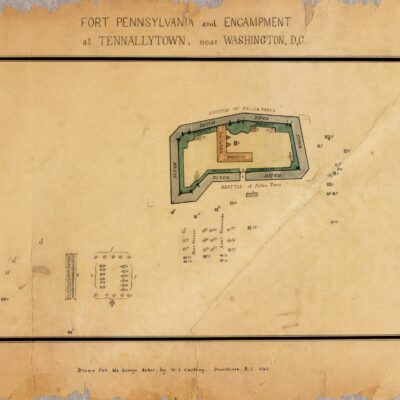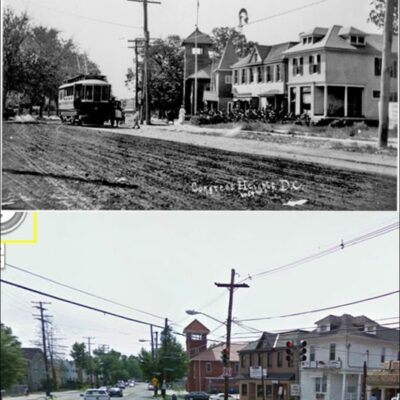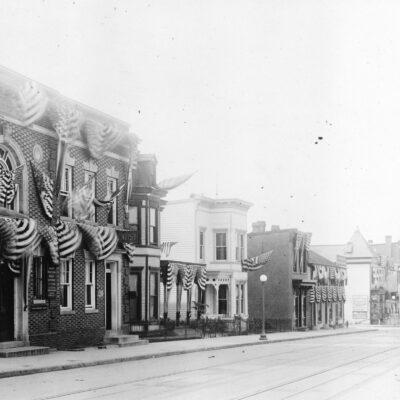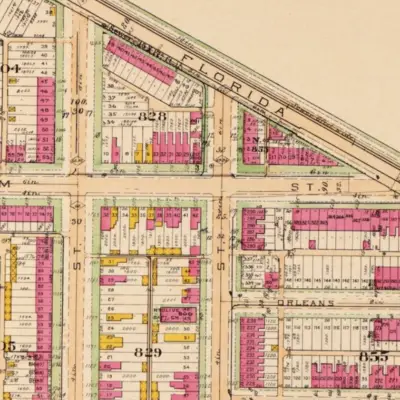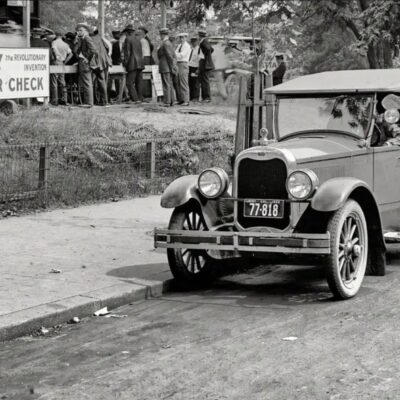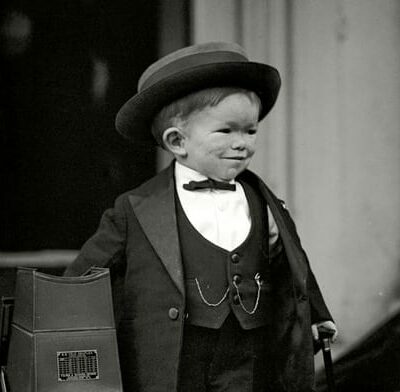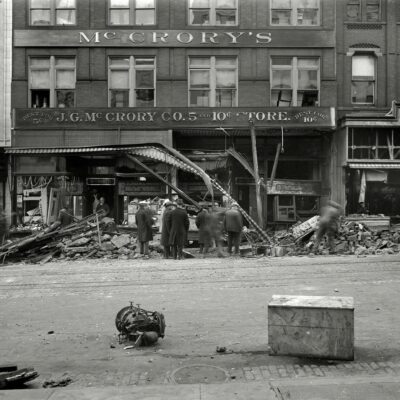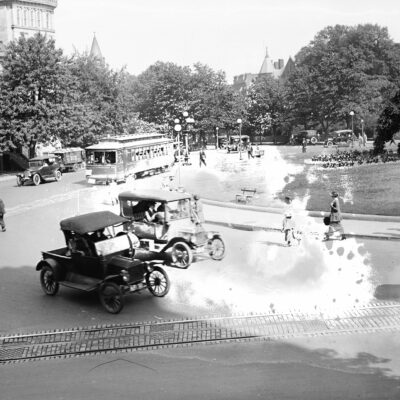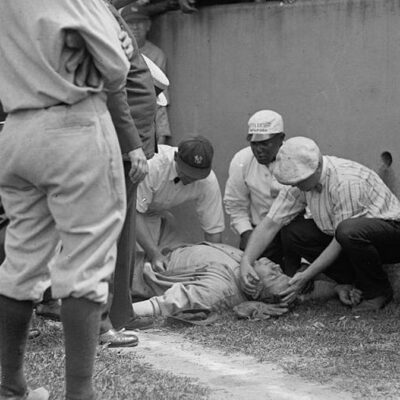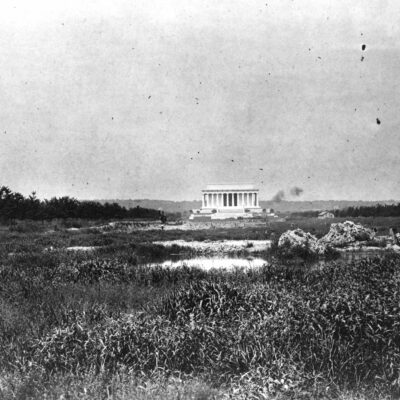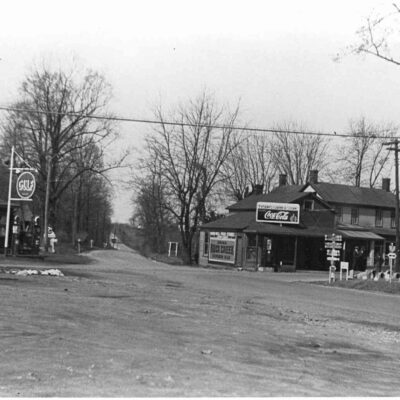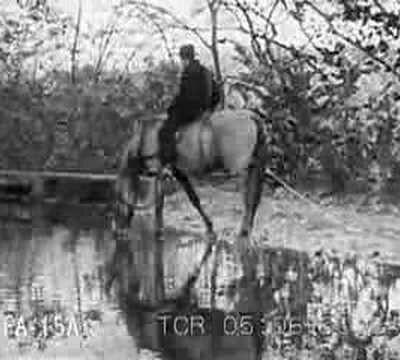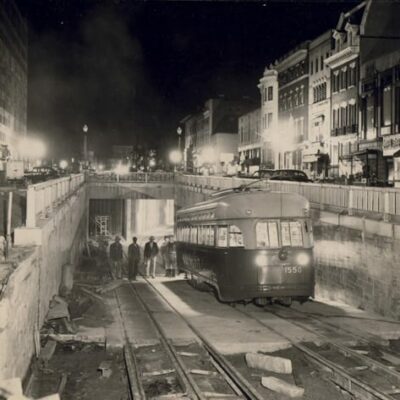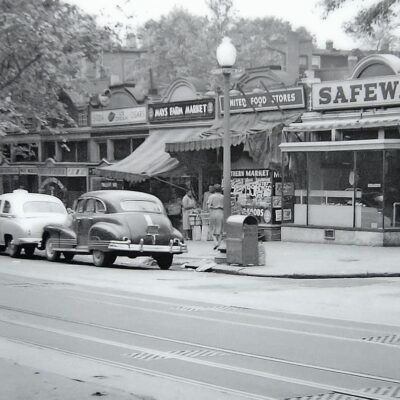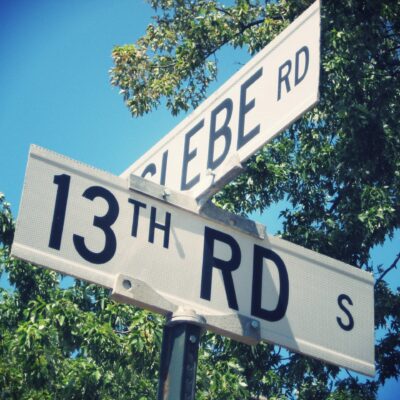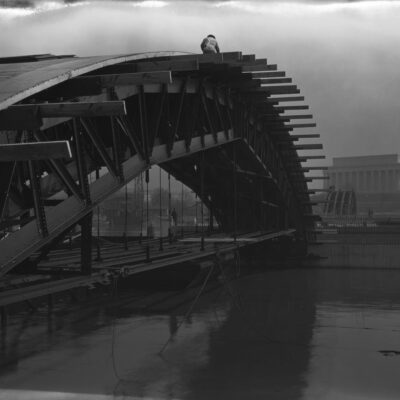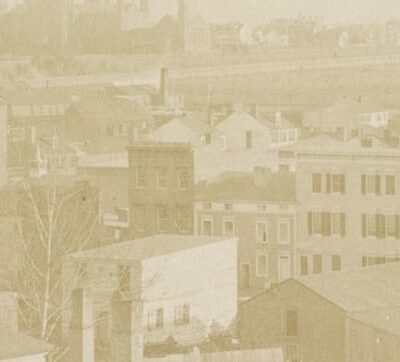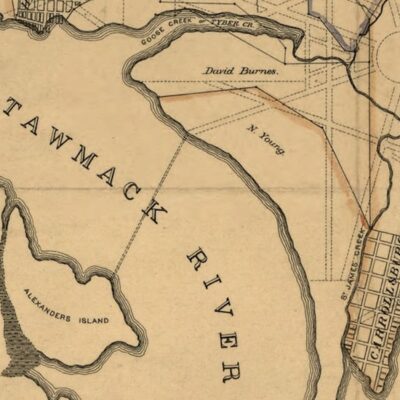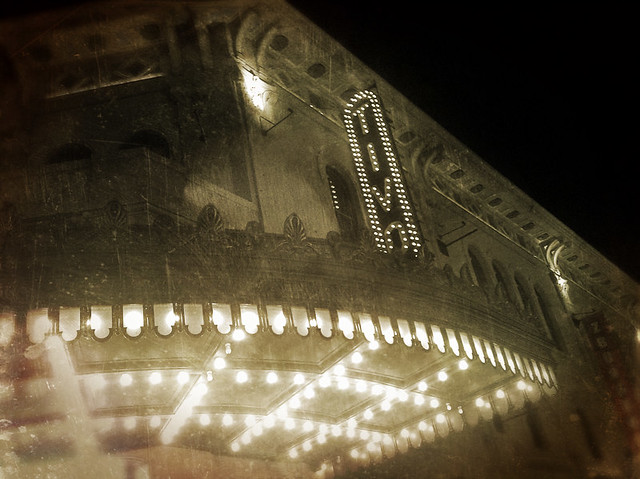
You can’t walk past the Tivoli Theater in Columbia Heights and not admire it, imagining what the surrounding streets were like in the late 1920s. The arrival of Harry Crandall’s new theater was a big deal for the area and let’s not forget that just a couple of years earlier, his Knickerbocker Theatre was the site of the catastrophic roof collapse that killed 98 people.
Here’s an article from the Washington Post on February 17th, 1924, before the opening.
Crandall’s New Tivoli theater at Fourteenth street and Park road northwest has been heralded ever since construction was started as the largest theater in Washington. This is an easy claim to make for any structure of this kind prior to the time when it takes definite shape and its actual dimensions both exterior and interest can be appraised.
Crandall’s Tivoli has now reached the stage of completion which makes it very clear indeed that it will be not theoretically, but actually the largest monumental edifice in the National Capital devoted exclusively to theatrical purposes. It has a frontage on Fourteenth street of almost an entire city square and more than half that frontage on Park road. This affords so tremendous a ground area that it is entirely feasible to deduct space on the Fourteenth street side for a series of smart shops and an even greater depth on Park road for lobby and promenade lounge purposes. The auditorium proper still remains a huge and magnificently beautified concourse with a comfortable seating capacity of 2,500 people.
The progress in decorating the Tivoli has been so rapid that it is already possible to gain a distinct impression of those qualities of beauty which will place the Tivoli at the top of the list of the most magnificent theaters on the continent. Every expert who has viewed the Tivoli so far, and there have been many, have reiterated belief that here is a house of which not only Washington, but the nation, may be proud. It is definitely schedule to open on April 1.
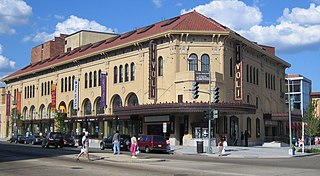
The picture this article paints is that of an incredibly impressive and opulent theater, the likes of which we won’t see again, which is sad. On the one hand, I’m thrilled that Anthony Williams’ administration pushed to save the building, but I’m bummed that it couldn’t be made a theater again.
I know it wouldn’t be able to survive as a movie theater these days, but how cool would that have been? Nevertheless, the city has done an excellent job at preserving an important piece of city history.
The opening was cause for major celebration and the city was greatly anticipating the new 2,500-seat picture house. When opened, tickets were advertised at 25 cents for matinées, plus a 2 cent war tax for any seat in the orchestra, loge or balcony (war tax in 1924? maybe to pay off World War I bonds). Children could attend a matinée for 20 cents plus a 2 cent tax for any seat.
Evening shows were twice the price at 50 cents with a 5 cent war tax for orchestra, 77 cents plus 8 cent tax in the loge and the balcony was 26 cents with a cent tax. Children could attend for 33 cent in the orchestra and 22 cents for the balcony.
Columbia Heights held a grand parade, the day before opening, to celebrate the arrival of the theater. The Washington Post reported that the parade was to be held on April 4th, 1924.
A parade will open the celebration of the opening of Tivoli theater, it was decided last night at a meeting of the community committee which has charge of the celebration. It is planned to stage the parade the night of April 4. The theater will be opened the following day amid a carnival of dancing, fireworks, music and other features.hist
A nominal charge will be made against firms entering floats, it was decided to cover the expense of decorations and music, etc. The executive committee will meet shortly to decide the route and time of starting. It is expected that it will traverse all of the principal downtown streets.
Several business firms have already notified Dr. J. V. MacKenzie, chairman of the parade committee, with office es in the Riggs national Bank building, Fourteenth street and Park road, that they would enter floats, it was said, and Commissioner E. L. Mattice, of the Boy Scouts promised that a sufficient number of scouts would be on hand to do their bit. It is likely that the scouts, strung out along the line of march, will be given sparklers to set off as the procession approaches to give it added color.
The route was selected shortly thereafter and reported in the Post on March 30th.
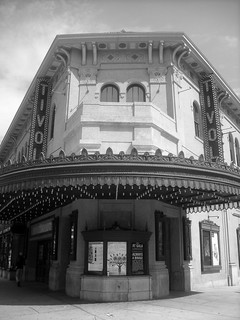
The route of the vehicle parade, which is to be the main faeture [sic] of the community Tivoli opening celebration Friday evening, was mapped out at a meeting of the executive committee of the community organization, held yesterday at the Arcade. Owners of several hundred delivery wagons, auto trucks, floats and pleasure cars have requested places in line. The People’s Drug Stores, the Arcade company and several other concerns with large business intrests [sic] in the Columbia Heights and neighboring sections, are arranging for floats. The Chestnut Farms Dairy hopes to have some of its horse-drawn vehicles in line, as well as a large number of its delivery autos. The laundries are planning to get some worthwhile attention from observers.
…
While the plan for assembling the participants has not been worked out, the parade will start at Seventeenth street and Pennsylvania avenue. It will move east to Fifteenth street, south to the Avenue again and along to Ninth street. There it will turn north to F street and west on F street to Fourteenth street, encircling the theater district. The parade will go up Fourteenth street to Shepherd street and then turn on Georgia avenue, to park road, to Mt. Pleasant street and disband at Columbia road.
Thanks to Google Maps, I’ve plotted this route for you.

Seats for the Saturday opening were put on sale Thursday morning starting at 10 a.m. and within three hours, all 2,500 seats were sold. Locals were abuzz with the notion that Washington had a grand theater to rival those in New York. The Washington Post wrote a glowing review of the new palace of motion pictures — built at a cost of $10 million — in the heart of Columbia Heights the following Monday.
Even the most extravagant expectation of commodiousness, comfort and beauty was more than fulfilled last night when the formal dedication of Crandall’s new Tivoli theater at Fourteenth street and Park road northwest marked on of the most brilliant events in Washington’s theatrical history.
The structure which represents an investment of $10,000,000, is architecturally imposing with exterior of highly ornamental polycrome terra cotta. The Fourteenth street frontage, extending almost the entire block from Park road to Monroe street, houses ten charming 2-story French shops with office suites on the third floor and studio apartments on the fourth, where also are located several of the dressing rooms utilized by those appearing on the Tivoli stage. The shops are unique in that each has a little open well, visible immediately upon entering the door, which permits simultaneous display of first and second floor stock. The entrance to the Tivoli offices is in the middle of the Fourteenth street block and is distinct from the theater entrance.
Studio apartments? I need to dig up some stories on old residents. That sounds fascinating. It reminds me of that recent documentary about New York Times photographer Bill Cunningham and his studio apartment in Carnegie Hall.
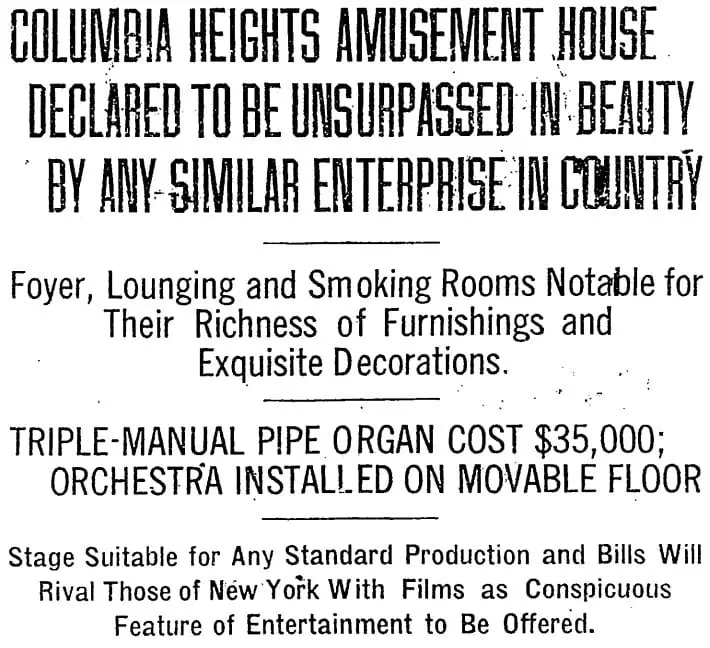
The article, which is quite long, continues to praise the extraordinary finishes of the interior, which will give you a nice sense of what it was like over 80 years ago.
Upon entering the theater one finds himself in a handsomely decorated domed foyer of exquisite design and extremely artistic finish. From the left side of this foyer a stairway descends to the smoking and lounging room for gentlemen that extends under the Park road lobby. Here is a great fireplace, comfortable divans and other practical appurtenances. Proceeding through the foyer the main lobby is reached, with its magnificent marble trimmings, wonderful lighting fixtures and mural oil paintings obviously executed by an artist of the highest rank. This lobby extends the length of the Park road side of the theater and has exit doors at the far end toward Thirteenth street. Then entrance to the auditorium proper is directly in the middle of the north side of the lobby and from each end of the lobby grand staircases, completely done in marble lead to the mezzanine and balcony.
On the mezzanine floor is the principal lounge paneled in mahogany and beautifully carpeted and furnished. From this delightful vantage point an impressive view of the lobby is permitted and direct entrance afforded to the mezzanine loge boxes which flank the projection booth which is so placed as to throw the picture straight at right angles upon the screen. Another novelty in the construction and placing of the booth is found in its location on the mezzanine tier.
This innovation made possible the installation of glass, wire-screened, fireproof doors opening directly into the promenade lounge from which patrons of the theater can view every process necessary to throw the pictured image upon the screen. It is expected that this peek behind the scenes, so to speak, will prove of great interest to the laity unfamiliar with the mechanical processes essential to the successful purveyance of their amusement.
Okay, no disrespect to Z-Burger (when are you opening?) or the old sushi place (which I liked) or Mayorga Coffee, but it’s too bad we can’t have what was just described above. Can you imagine how amazing that would be?
It was so impressive at the time that just about every company involved in the construction placed advertisements in the Washington Post to associate themselves with the theater.
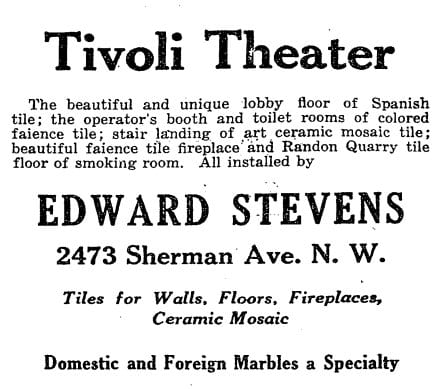
This next bit is some serious technical wizardry, especially for the 1920s.
As a radical departure from usual theater custom as the Tivoli’s revelation of the working projection booth, is found in the type of orchestra pit with which the house has been supplied. The floor on which the orchestra sits is in reality an elevator. The orchestra can be lowered to the basement level, or raised to stage level without disturbing a member or occasioning the discontinuance of a seletion. The same is true of the organ console, which likewise is on an elevator of its own, and can be raised and lowered simultaneously with or independently of the organ.
…
It is futile to attempt to convey by the printed word any adequate notion of the size, the completeness or the atmosphere of artistic achievement with which the Tivoli impresses the spectator upon his first visit. On every hand there is evidence of tremendous expenditure of thought and creative genius in attaining the final effect, and it is obvious that the house as dedicated last night must easily have cost the $1,000,000 its completion is said to represent.
…
The Tivoli is not in the usual sense a “neighborhood house.” It is, on the contrary, an institution of which the entire city of Washington ought to be proud and ought to be anxious to support. It is quite deserving of the description of “The Temple of the Arts” which has already been bestowed upon it.
…
In the Tivoli theater the Capital has a monumental edifice of which Mr. Crandall and the nation may both well be proud.
Are you impressed? I am … thoroughly. Also, the article mentioned $10 million first, then the $1 million figure. I think the former is a typo. That was a ton of money in 1924, and I’m guessing an additional zero was added.
It’s sad that we’ll probably never have places like this in the city today, but it’s great to dig into the past and imagine what it was like. I’m sure many of you agree and hopefully when you’re hanging out at the Columbia Heights Farmer’s Market (we really have to wait until May for this?) with your friends this summer, you can share some of these stories and descriptions with them.
Oh, and one last thing. The manager of the theater when it opened was Harry E. Lohmeyer, an employee of Crandall’s for many years who had been promoted to the most prestigious position at the Tivoli. He was 35 years old when the theater opened. According to the 1930 U.S. Census, he lived at 6215 4th St. NW … a little bit of a hike, almost in Takoma. He owned his home, valued at $12,000, living with his wife of 16 years, Mary, and two sons, Theodore, 15, and Harry Jr., 5.
To be the manager of this epicenter of entertainment was undoubtedly a major achievement and both Mary and his little boy Theodore were both likely quite proud witnessing the parade through Washington’s streets and opening of the theater the following night.
Hey, maybe Officer Sprinkle was in attendance on opening night.
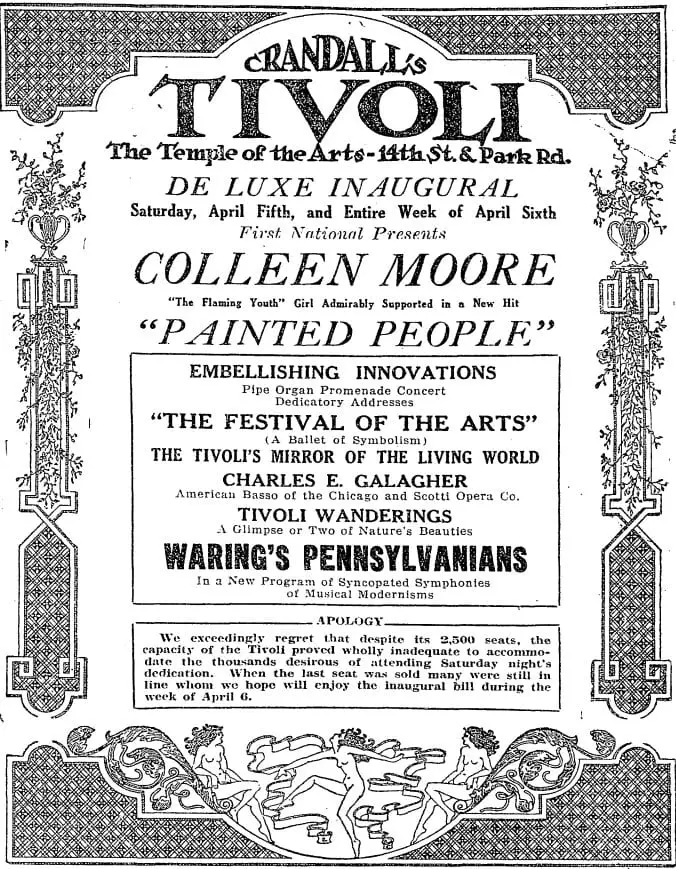
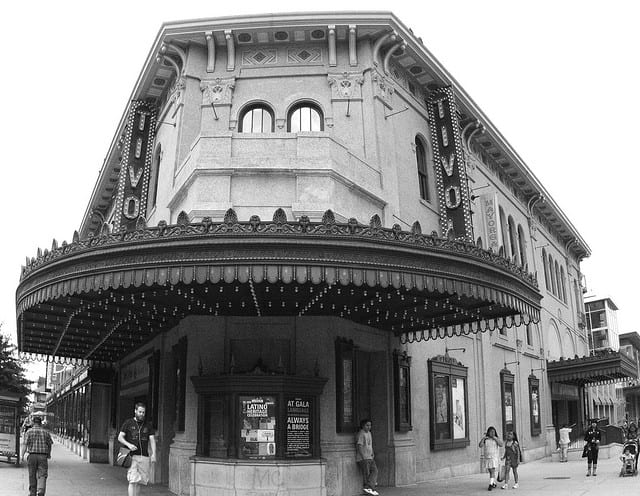
This was a fun post to look into, partly because I walk by this theater almost daily. I hope you enjoyed it, and if you did, why not follow us on Twitter of Facebook to get updates?

